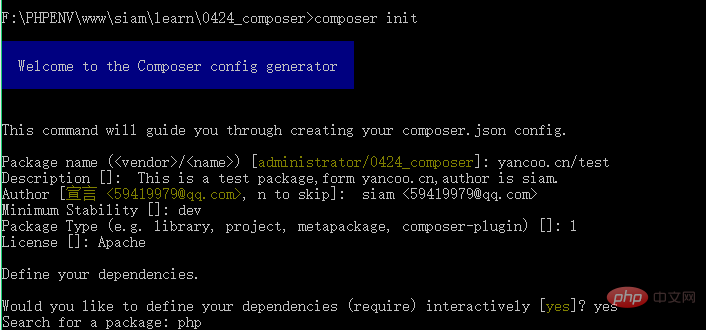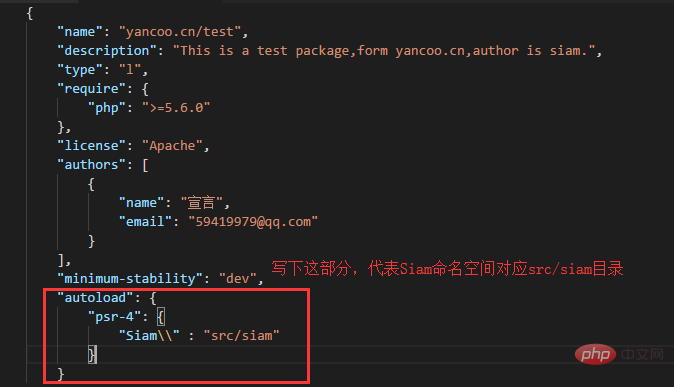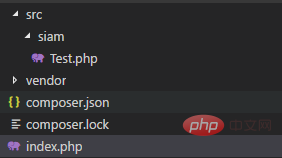How to write composer package
Before introducing how to write the composer package, you can learn how to install composer and its related usage through the composer usage tutorial column.

How to write the composer package?
Write your own composer package
The composer package is suitable for use when you need to cooperate with other dependent packages.
Let’s write our own composer package. First, we create an empty directory and run the following command to initialize a blank composer package
composer init
You can see the return in the command window Tip;
You need to enter the package name
This command will guide you through creating your composer.json config.` Package name (<vendor>/<name>) :
What I wrote here is yancoo.cn/test, press Enter
You need to enter the description
Description []:
Package description content
You need to enter the author
Author [宣言 <59419979@qq.com>, n to skip]:
If there is a default value for this option, you can directly Enter
You need to enter the minimum stable version
Minimum Stability []:
This option has optional values: stable, RC, beta, alpha, dev. Generally fill in dev
Need to enter the package type
Package Type (e.g. library, project, metapackage, composer-plugin) []:
The options are already available in the prompt, we usually choose library and fill in l
Need to enter the open source agreement
License []:
Fill in according to your own situation, we fill in Apache
Set other environments or packages that the package needs to depend on
Define your dependencies. Would you like to define your dependencies (require) interactively [yes]?
If you need to set the dependent environment or For other packages, enter yes and press Enter, which will let you search. We set the php version for the package here to be greater than 5.6, so search for php.
Enter the version constraint to require (or leave blank to use the latest version):
Enter the minimum required version number>=5.6.0

If you need to set multiple environment requirements, repeat the search Just fill it in. If you don’t need it, just press Enter without filling in the content in Search for a package:
Next, set the dependent package
Would you like to define your dev dependencies (require-dev) interactively [yes]?
us No need to press Enter directly.
{
"name": "yancoo.cn/test",
"description": "This is a test package,form yancoo.cn,author is siam.",
"type": "l",
"require": {
"php": ">=5.6.0"
},
"license": "Apache",
"authors": [
{
"name": "宣言",
"email": "59419979@qq.com"
}
],
"minimum-stability": "dev"
}
Do you confirm generation [yes]?Confirm the message, yes and press Enter. Initialization is complete
Do you confirm generation [yes]? yes Would you like to install dependencies now [yes]? yes
The installation is complete. You can see that our directory has generated the following structure.

vendor is the address where composer stores packages. All packages are stored in this path for unified management, and composer provides the function of automatic loading of namespaces. We are using We only need to introduce the unified entry file of composer
require "vendor/autoload.php";
But we also need to write in the configuration file of the package which directory needs to be automatically loaded to be effective!
Edit composer.json file

The path here needs to be determined according to your own, you can also refer to the above writing method .
After writing, you need to run the command line composer dump-autoload to update the composer's namespace and folder mapping relationship.
The previous step is very important. If you miss it, it will not be executed normally.
Then we create the src folder, then create the siam folder, and create the Test.php file in it
Write the namespace Siam; According to the psr-4 specification, the class name must be the same as the file name same.
<?php
//Test.php文件
namespace Siam;
class Test
{
function test()
{
echo "Form Test -> test()";
}
}Write the index.php test file in the outermost layer. The correct way is to create a demo folder and then write the test file.
test();
So our current file directory structure is as follows. Run index.php to get the content correctly. Form Test -> test()

You can customize it according to your own To write classes, you only need to pay attention to the fact that the namespace level is the same as the folder level, and the class name is the same as the file name to load automatically.
The above is the detailed content of How to write composer package. For more information, please follow other related articles on the PHP Chinese website!

Hot AI Tools

Undresser.AI Undress
AI-powered app for creating realistic nude photos

AI Clothes Remover
Online AI tool for removing clothes from photos.

Undress AI Tool
Undress images for free

Clothoff.io
AI clothes remover

Video Face Swap
Swap faces in any video effortlessly with our completely free AI face swap tool!

Hot Article

Hot Tools

Notepad++7.3.1
Easy-to-use and free code editor

SublimeText3 Chinese version
Chinese version, very easy to use

Zend Studio 13.0.1
Powerful PHP integrated development environment

Dreamweaver CS6
Visual web development tools

SublimeText3 Mac version
God-level code editing software (SublimeText3)

Hot Topics
 1386
1386
 52
52
 Solve caching issues in Craft CMS: Using wiejeben/craft-laravel-mix plug-in
Apr 18, 2025 am 09:24 AM
Solve caching issues in Craft CMS: Using wiejeben/craft-laravel-mix plug-in
Apr 18, 2025 am 09:24 AM
When developing websites using CraftCMS, you often encounter resource file caching problems, especially when you frequently update CSS and JavaScript files, old versions of files may still be cached by the browser, causing users to not see the latest changes in time. This problem not only affects the user experience, but also increases the difficulty of development and debugging. Recently, I encountered similar troubles in my project, and after some exploration, I found the plugin wiejeben/craft-laravel-mix, which perfectly solved my caching problem.
 Use Composer to solve dependency injection: application of PSR-11 container interface
Apr 18, 2025 am 07:39 AM
Use Composer to solve dependency injection: application of PSR-11 container interface
Apr 18, 2025 am 07:39 AM
I encountered a common but tricky problem when developing a large PHP project: how to effectively manage and inject dependencies. Initially, I tried using global variables and manual injection, but this not only increased the complexity of the code, it also easily led to errors. Finally, I successfully solved this problem by using the PSR-11 container interface and with the power of Composer.
 How to solve the problem of JavaScript error handling using Composer
Apr 18, 2025 am 08:30 AM
How to solve the problem of JavaScript error handling using Composer
Apr 18, 2025 am 08:30 AM
I'm having a tough problem when developing a complex web application: how to effectively handle JavaScript errors and log them. I tried several methods, but none of them could meet my needs until I discovered the library dvasilenko/alterego_tools. I easily solved this problem through the installation of this library through Composer and greatly improved the maintainability and stability of the project. Composer can be learned through the following address: Learning address
 How to quickly build LaravelCMS with Composer: mki-labs/espresso practical experience
Apr 18, 2025 am 07:36 AM
How to quickly build LaravelCMS with Composer: mki-labs/espresso practical experience
Apr 18, 2025 am 07:36 AM
I encountered a tricky problem when developing a new Laravel project: how to quickly build a fully functional and easy-to-manage content management system (CMS). I tried multiple solutions, but all gave up because of complex configuration and inconvenient maintenance. Until I discovered the LaravelCMS package mki-labs/espresso, which not only simple to install, but also provides powerful functions and intuitive management interface, which completely solved my problem.
 How to use Composer to solve the problem of batch processing of data under Yii framework
Apr 18, 2025 am 07:54 AM
How to use Composer to solve the problem of batch processing of data under Yii framework
Apr 18, 2025 am 07:54 AM
When developing Yii framework projects, you often encounter situations where you need to obtain a large amount of data from the database. If appropriate measures are not taken, directly obtaining all data may cause memory overflow and affect program performance. Recently, when I was dealing with a project on a large e-commerce platform, I encountered this problem. After some research and trial, I finally solved the problem through the extension library of pavle/yii-batch-result.
 How to resolve HTTP request issues using Composer: A practical guide to the yiche/http library
Apr 18, 2025 am 08:06 AM
How to resolve HTTP request issues using Composer: A practical guide to the yiche/http library
Apr 18, 2025 am 08:06 AM
During development, HTTP requests are often required, which may be to get data, send data, or interact with external APIs. However, when faced with complex network environments and changing request requirements, how to efficiently handle HTTP requests becomes a challenge. I have encountered a problem in a project: I need to send requests to different APIs frequently, and log the requests to facilitate subsequent debugging and analysis. After trying several methods, I discovered the yiche/http library. It not only simplifies the processing of HTTP requests, but also provides dynamic logging functions, greatly improving development efficiency.
 How to use Composer to improve the security of Laravel applications: Applications of wiebenieuwenhuis/laravel-2fa library
Apr 18, 2025 am 11:36 AM
How to use Composer to improve the security of Laravel applications: Applications of wiebenieuwenhuis/laravel-2fa library
Apr 18, 2025 am 11:36 AM
When developing a Laravel application, I encountered a common but difficult problem: how to improve the security of user accounts. With the increasing complexity of cyber attacks, a single password protection is no longer enough to ensure the security of users' data. I tried several methods, but the results were not satisfactory. Finally, I installed the wiebenieuwenhuis/laravel-2fa library through Composer and successfully added two-factor authentication (2FA) to my application, greatly improving security.
 Laravel framework installation method
Apr 18, 2025 pm 12:54 PM
Laravel framework installation method
Apr 18, 2025 pm 12:54 PM
Article summary: This article provides detailed step-by-step instructions to guide readers on how to easily install the Laravel framework. Laravel is a powerful PHP framework that speeds up the development process of web applications. This tutorial covers the installation process from system requirements to configuring databases and setting up routing. By following these steps, readers can quickly and efficiently lay a solid foundation for their Laravel project.




